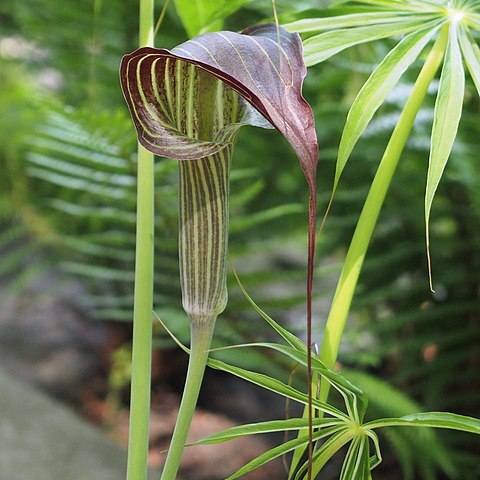Tuber depressed globose, 2-7 cm in diam. Cataphylls 3, dark green, with whitish striae or spots, to 55 cm, acute at apex. Petiole and peduncle green, smooth, unmarked. Leaf solitary, occasionally 2; petiole to 100 × ca. 2 cm, proximal ca. 50 cm sheathing into pseudostem; leaf blade radiate; leaflets 18-23, sessile, green abaxially, dull green adaxially, narrowly elliptic or narrowly linear, 16-28 cm × 2-20 mm, base cuneate, apex long acuminate and caudate, with filiform tail 7-10 cm; veins raised abaxially, impressed adaxially; lateral veins numerous, obliquely ascending. Peduncle shorter than petioles, to 75 cm, free part ca. 9 cm. Spathe green, with indistinct whitish stripes or not; tube cylindric, 6-7 × ca. 1.5 cm, auriculate and recurved at throat; limb deep green sometimes with purple margin outside, pale green inside, triangular-ovate, 8-12 × 4-8 cm, apex acuminate with long purple filiform tail, arching; tail to 35 cm, pendulous. Spadix unisexual; female zone conic, ca. 3.5 × 1.5 cm; ovary green, obovoid; stigma sessile, spherical, pilose; male zone cylindric, 4-4.5 cm × 4-5 mm; synandria dark violet; anthers subsessile, 2 or 3, dehiscent by apical pores. Appendix pale green, cylindric or narrowly conic, ca. 7 cm × 2-4 mm, with some acute neuter flowers at base. Infructescence nodding. Berries red. Fl. Jun-Jul.
More
A herb. It is a taro family plant. The tuber is round and flattened and 2-7 cm across. There is one leaf. The leaf stalk is 100 cm long by 2 cm wide. There are 18-23 leaflets spread out in a ring. They are narrowly oval and 16-28 cm long by 2-20 mm wide. The flower stalk is 75 cm long. The fruit are red berries.

